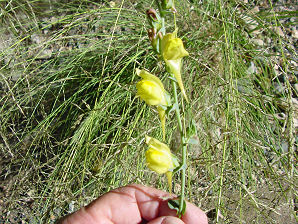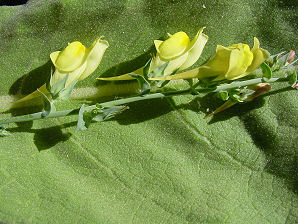Arizona Wild Flowers
Pictures, Photos, Images
Descriptions, Information, Reviews.
Dalmation Toadflax, Linaria dalmatica.
We Are Proud Of Our SafeSurf Rating!
Click On Any Of The Following Links By Amazon.Com
For Books, & Videos About Wildflowers Of Arizona & The Southwest USA. No Obligation!
| Dalmation Toadflax, Linaria dalmatica. Photo Taken June 18, 2005. |
|---|
 |  |
| Dalmation Toadflax, Linaria dalmatica | Dalmation Toadflax, Linaria dalmatica |
|---|
Dalmation Toadflax.
We wish to thank Wikipedia, the free encyclopedia for some of the information on this page. We share images and information with Wikipedia. Linaria dalmatica is a herbaceous plant native to western Asia and southeastern Europe that has become a weed in other areas of the world including the USA. Its common names include Balkan toadflax, broadleaf toadflax, and Dalmatian toadflax Dalmatian toadflax is a deep-rooted, short-lived herbaceous perennial that grows up to 4 feet tall. Waxy green leaves are heart shaped, 1 to 3 inches long, and clasp the stem. Flowers are 1 inch long (excluding the 1/2-inch spur), yellow, often tinged with orange or red, and similar in shape to snapdragon. Plants flower from midsummer to fall. Seeds are produced in a �-inch pod and are irregularly wing angled.
Dalmatian toadflax is primarily a weed of the intermountain West. A native of the Mediterranean region, and of western Asia and southeastern Europe is also known as "butter and eggs" or "wild snapdragon." In Europe Dalmatian Toadflax has been cultivated as an ornamental for nearly four centuries, and was brought to the west coast of North America as an ornamental about 1874. In the USA the plant is considered a noxious invasive weed.
Quick Notes:
Height: Up to about 48 inches. Spreading out to about 48 inches wide.
Flowers: Flowers grow at the bases of the upper leaves and are bright yellow with an orange center and a spur on the end that is approximately as long as the rest of the flower.
Flowering Time: June - July.
Leaves: Leaves are heart shaped 1 to 3 inches long, sometimes lanceolate shape, especially on the lower portions of the plant and the bases tend to wrap around the stem. Blue - green in color.
Found: Native to the Mediterranean region, and of western Asia and southeastern Europe.
Hardiness:
Soil pH requirements:
Sun Exposure:
Elevation: 4,500 - 7,000 Feet.
Habitat: On roadsides, flats, banks of streambeds, rocky hillsides, disturbed rocky ground.
Miscellaneous: Flowering Photos Taken June 18, 2005 at Lynx Creek, Prescott, Arizona.
|
We Are Proud Of Our SafeSurf Rating!
Click On Any Of The Following Links By Amazon.Com
For Books, & Videos About Wildflowers Of Arizona & The Southwest USA. No Obligation!
| © 1966 - Present, Audrey, Eve, & George DeLange |